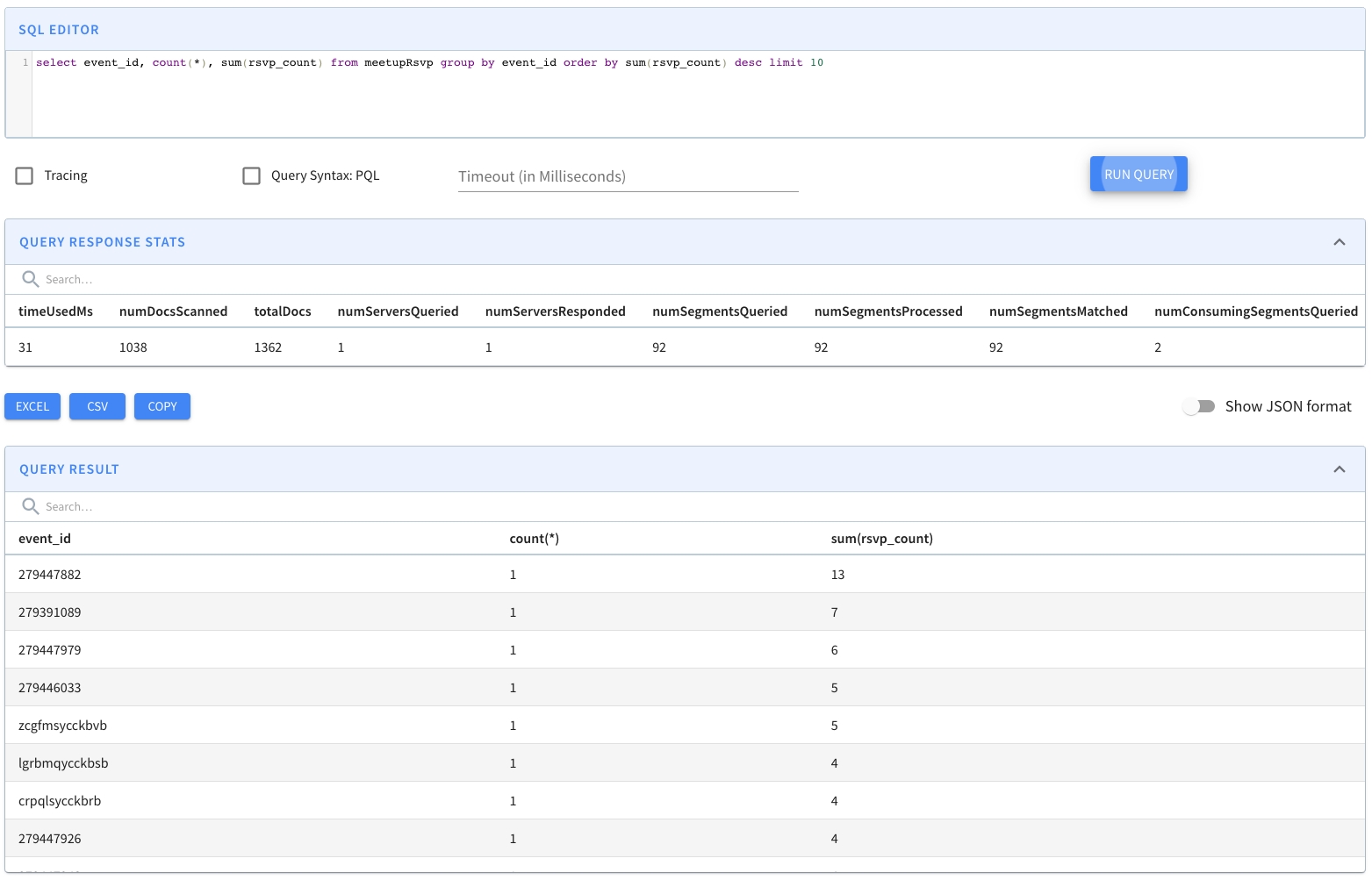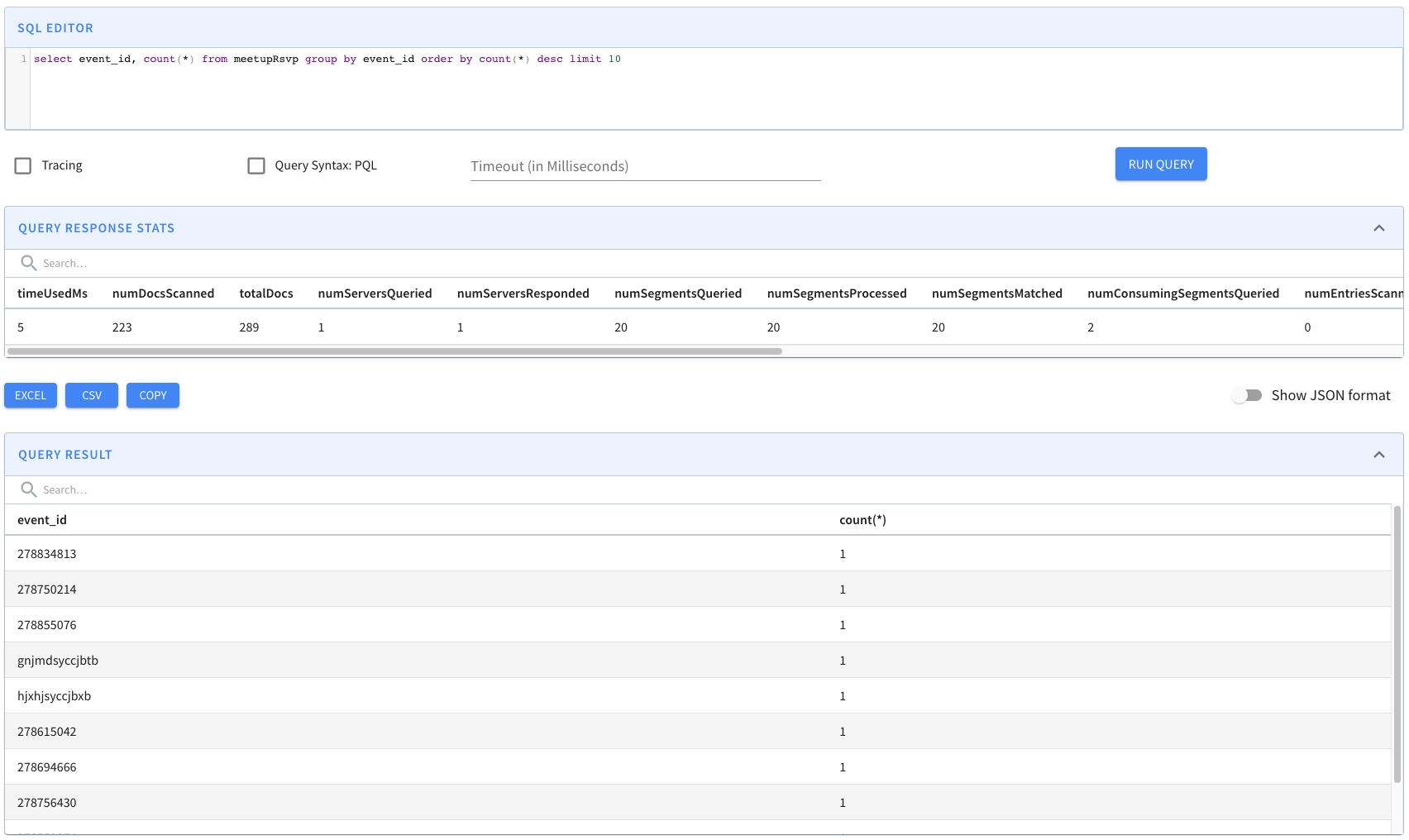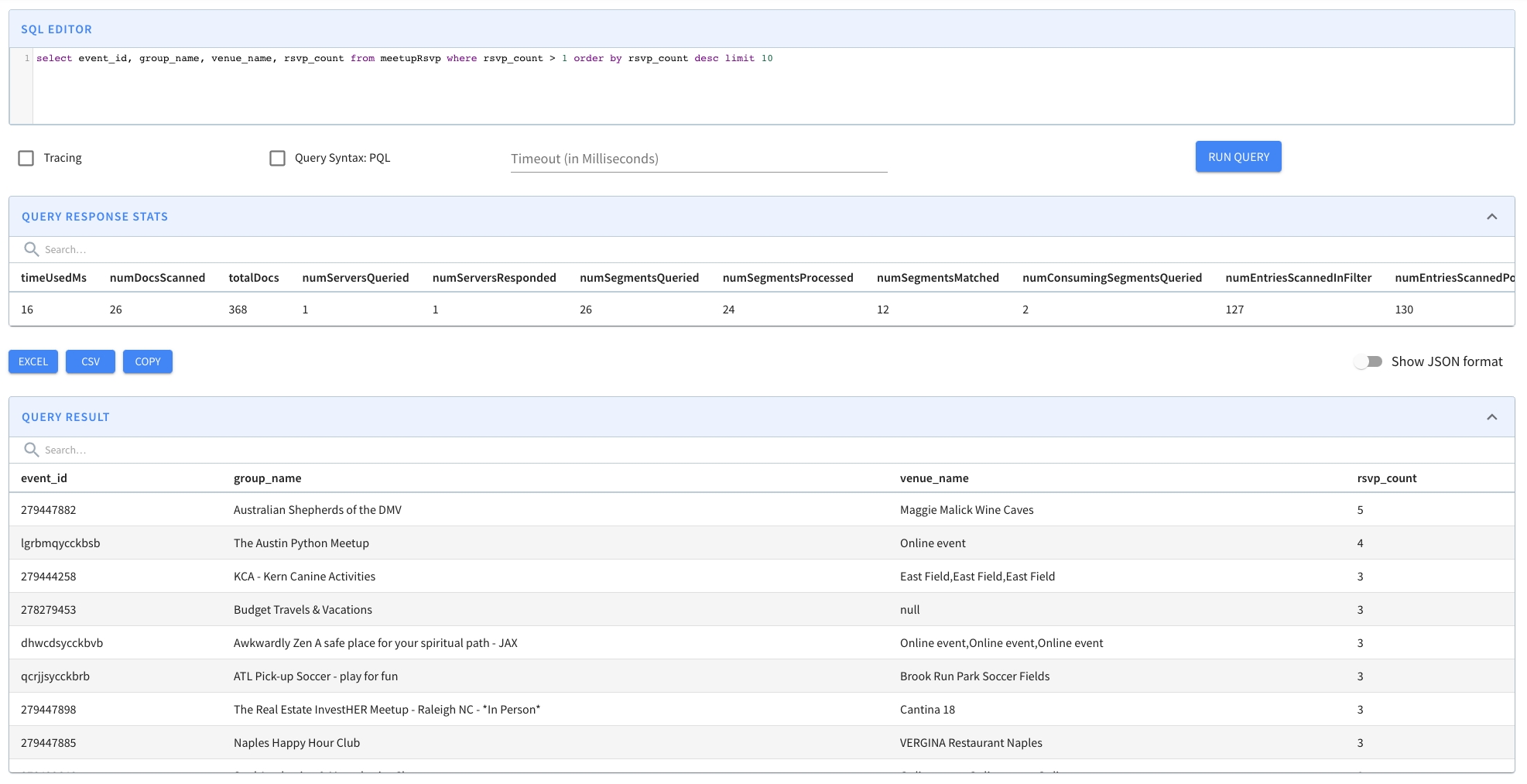Stream Ingestion with Upsert
Upsert support in Apache Pinot.
Pinot provides native support of upserts during real-time ingestion. There are scenarios where records need modifications, such as correcting a ride fare or updating a delivery status.
Partial upserts are convenient as you only need to specify the columns where values change, and you ignore the rest.
Overview of upserts in Pinot
See an overview of how upserts work in Pinot 1.0.
Enable upserts in Pinot
To enable upserts on a Pinot table, do the following:
Define the primary key in the schema
To update a record, you need a primary key to uniquely identify the record. To define a primary key, add the field primaryKeyColumns to the schema definition. For example, the schema definition of UpsertMeetupRSVP in the quick start example has this definition.
Note this field expects a list of columns, as the primary key can be a composite.
When two records of the same primary key are ingested, the record with the greater comparison value (timeColumn by default) is used. When records have the same primary key and event time, then the order is not determined. In most cases, the later ingested record will be used, but this may not be true in cases where the table has a column to sort by.
Partition the input stream by the primary key
An important requirement for the Pinot upsert table is to partition the input stream by the primary key. For Kafka messages, this means the producer shall set the key in the send API. If the original stream is not partitioned, then a streaming processing job (such as with Flink) is needed to shuffle and repartition the input stream into a partitioned one for Pinot's ingestion.
Additionally if using segmentPartitionConfigto leverage Broker segment pruning then it's important to ensure that the partition function used matches both on the Kafka producer side as well as Pinot. In Kafka default for Java client is 32-bit murmur2 hash and for all other languages such as Python its CRC32 (Cyclic Redundancy Check 32-bit).
Enable upsert in the table configurations
To enable upsert, make the following configurations in the table configurations.
Upsert modes
Full upsert
The upsert mode defaults to FULL . FULL upsert means that a new record will replace the older record completely if they have same primary key. Example config:
Partial upserts
Partial upsert lets you choose to update only specific columns and ignore the rest.
To enable the partial upsert, set the mode to PARTIAL and specify partialUpsertStrategies for partial upsert columns. Since release-0.10.0, OVERWRITE is used as the default strategy for columns without a specified strategy. defaultPartialUpsertStrategy is also introduced to change the default strategy for all columns.
Note that null handling must be enabled for partial upsert to work.
For example:
Pinot supports the following partial upsert strategies:
OVERWRITE
Overwrite the column of the last record
INCREMENT
Add the new value to the existing values
APPEND
Add the new item to the Pinot unordered set
UNION
Add the new item to the Pinot unordered set if not exists
IGNORE
Ignore the new value, keep the existing value (v0.10.0+)
MAX
Keep the maximum value betwen the existing value and new value (v0.12.0+)
MIN
Keep the minimum value betwen the existing value and new value (v0.12.0+)
With partial upsert, if the value is null in either the existing record or the new coming record, Pinot will ignore the upsert strategy and the null value:
(null, newValue) -> newValue
(oldValue, null) -> oldValue
(null, null) -> null
None upserts
If set mode to NONE, the upsert is disabled.
Comparison column
By default, Pinot uses the value in the time column (timeColumn in tableConfig) to determine the latest record. That means, for two records with the same primary key, the record with the larger value of the time column is picked as the latest update. However, there are cases when users need to use another column to determine the order. In such case, you can use option comparisonColumn to override the column used for comparison. For example,
For partial upsert table, the out-of-order events won't be consumed and indexed. For example, for two records with the same primary key, if the record with the smaller value of the comparison column came later than the other record, it will be skipped.
Multiple comparison columns
In some cases, especially where partial upsert might be employed, there may be multiple producers of data each writing to a mutually exclusive set of columns, sharing only the primary key. In such a case, it may be helpful to use one comparison column per producer group so that each group can manage its own specific versioning semantics without the need to coordinate versioning across other producer groups.
Documents written to Pinot are expected to have exactly 1 non-null value out of the set of comparisonColumns; if more than 1 of the columns contains a value, the document will be rejected. When new documents are written, whichever comparison column is non-null will be compared against only that same comparison column seen in prior documents with the same primary key. Consider the following examples, where the documents are assumed to arrive in the order specified in the array.
The following would occur:
orderReceived: 1
Result: persisted
Reason: first doc seen for primary key "aa"
orderReceived: 2
Result: persisted (replacing
orderReceived: 1)Reason: comparison column (
secondsSinceEpoch) larger than that previously seen
orderReceived: 3
Result: rejected
Reason: comparison column (
secondsSinceEpoch) smaller than that previously seen
orderReceived: 4
Result: persisted (replacing
orderReceived: 2)Reason: comparison column (
otherComparisonColumn) larger than previously seen (never seen previously), despite the value being smaller than that seen forsecondsSinceEpoch
orderReceived: 5
Result: rejected
Reason: comparison column (
otherComparisonColumn) smaller than that previously seen
orderReceived: 6
Result: persist (replacing
orderReceived: 4)Reason: comparison column (
otherComparisonColumn) larger than that previously seen
Delete column
Upsert Pinot table can support soft-deletes of primary keys. This requires the incoming record to contain a dedicated boolean single-field column that serves as a delete marker for a primary key. Once the real-time engine encounters a record with delete column set to true , the primary key will no longer be part of the queryable set of documents. This means the primary key will not be visible in the queries, unless explicitly requested via query option skipUpsert=true.
Note that the delete column has to be a single-value boolean column.
Note that when deleteRecordColumn is added to an existing table, it will require a server restart to actually pick up the upsert config changes.
A deleted primary key can be revived by ingesting a record with the same primary, but with higher comparison column value(s).
Note that when reviving a primary key in a partial upsert table, the revived record will be treated as the source of truth for all columns. This means any previous updates to the columns will be ignored and overwritten with the new record's values.
Deleted Keys time-to-live (TTL)
The above config deleteRecordColumn only soft-deletes the primary key. To decrease in-memory data and improve performance, minimize the time deleted-primary-key entries are stored in the metadata map (deletedKeys time-to-live (TTL)). Limiting the TTL is especially useful for deleted-primary-keys where there are no future updates foreseen.
Configure how long deleted-primary-keys are stored in metadata
To configure how long primary keys are stored in metadata, specify the length of time in deletedKeysTTL For example:
In this example, Pinot will retain the deleted-primary-keys in metadata for 1 day.
Note that the value of this field deletedKeysTTL should be the same as the unit of comparison column. If your comparison column is having values which corresponds to seconds, this config should also have values in seconds (see above example).
Use strictReplicaGroup for routing
The upsert Pinot table can use only the low-level consumer for the input streams. As a result, it uses the partitioned replica-group assignment implicitly for the segments. Moreover, upsert poses the additional requirement that all segments of the same partition must be served from the same server to ensure the data consistency across the segments. Accordingly, it requires to use strictReplicaGroup as the routing strategy. To use that, configure instanceSelectorType in Routing as the following:
Using implicit partitioned replica-group assignment from low-level consumer won't persist the instance assignment (mapping from partition to servers) to the ZooKeeper, and new added servers will be automatically included without explicit reassigning instances (usually through rebalance). This can cause new segments of the same partition assigned to a different server and break the requirement of upsert.
To prevent this, we recommend using explicit partitioned replica-group instance assignment to ensure the instance assignment is persisted. Note that numInstancesPerPartition should always be 1 in replicaGroupPartitionConfig.
Enable validDocIds snapshots for upsert metadata recovery
Upsert snapshot support is also added in release-0.12.0. To enable the snapshot, set the enableSnapshot to true. For example:
Upsert maintains metadata in memory containing which docIds are valid in a particular segment (ValidDocIndexes). This metadata gets lost during server restarts and needs to be recreated again. ValidDocIndexes can not be recovered easily after out-of-TTL primary keys get removed. Enabling snapshots addresses this problem by adding functions to store and recover validDocIds snapshot for Immutable Segments
The snapshots are taken on every segment commit to ensure that they are consistent with the persisted data in case of abrupt shutdown. We recommend that you enable this feature so as to speed up server boot times during restarts.
The lifecycle for validDocIds snapshots are shows as follows,
If snapshot is enabled, load validDocIds from snapshot during add segments.
If snapshot is not enabled, delete validDocIds snapshots during add segments if exists.
If snapshot is enabled, persist validDocIds snapshot for immutable segments when removing segment.
Enable preload for faster restarts
Upsert preload support is also added in master. To enable the preload, set the enablePreload to true. For example:
For preload to improve your restart times, enableSnapshot: true should also we set in the table config.
Under the hood, it uses the snapshots to quickly insert the data instead of performing a whole upsert comparison flow for all the primary keys. The flow is triggered before server is marked as ready to load segments without snapshots (hence the name preload).
The feature also requires you to specify pinot.server.instance.max.segment.preload.threads: N in the server config where N should be replaced with the number of threads that should be used for preload.
This feature is still in beta.
Metadata time-to-live (TTL)
In Pinot, the metadata map is stored in heap memory. To decrease in-memory data and improve performance, minimize the time primary key entries are stored in the metadata map (metadata time-to-live (TTL)). Limiting the TTL is especially useful for primary keys with high cardinality and frequent updates.
Configure how long primary keys are stored in metadata
To configure how long primary keys are stored in metadata, specify the length of time in upsertTTL. For example:{
In this example, Pinot will retain primary keys in metadata for 3 days.
Handle out-of-order events
There are 2 configs added related to handling out-of-order events.
dropOutOfOrderRecord
To enable dropping of out-of-order record, set the dropOutOfOrderRecord to true. For example:
This feature doesn't persist any out-of-order event to the consuming segment. If not specified, the default value is false.
When
false, the out-of-order record gets persisted to the consuming segment, but the MetadataManager mapping is not updated thus this record is not referenced in query or in any future updates. You can still see the records when usingskipUpsertquery option.When
true, the out-of-order record doesn't get persisted at all and the MetadataManager mapping is not updated so this record is not referenced in query or in any future updates. You cannot see the records when usingskipUpsertquery option.
outOfOrderRecordColumn
This is to identify out-of-order events programmatically. To enable this config, add a boolean field in your table schema, say isOutOfOrder and enable via this config. For example:
This feature persists a true / false value to the isOutOfOrder field based on the orderness of the event. You can filter out out-of-order events while using skipUpsert to avoid any confusion. For example:
Upsert table limitations
There are some limitations for the upsert Pinot tables.
The upsert feature is supported for Real-time tables only, and not for Hybrid or Offline tables.
The high-level consumer is not allowed for the input stream ingestion, which means
stream.[consumerName].consumer.typemust always belowLevel.The star-tree index cannot be used for indexing, as the star-tree index performs pre-aggregation during the ingestion.
Unlike append-only tables, out-of-order events (with comparison value in incoming record less than the latest available value) won't be consumed and indexed by Pinot partial upsert table, these late events will be skipped.
Best practices
Unlike other real-time tables, Upsert table takes up more memory resources as it needs to bookkeep the record locations in memory. As a result, it's important to plan the capacity beforehand, and monitor the resource usage. Here are some recommended practices of using Upsert table.
Create the topic/stream with more partitions.
The number of partitions in input streams determines the partition numbers of the Pinot table. The more partitions you have in input topic/stream, more Pinot servers you can distribute the Pinot table to and therefore more you can scale the table horizontally. Do note that you can't increase the partitions in future for upsert enabled tables so you need to start with good enough partitions (atleast 2-3X the number of pinot servers)
Memory usage
Upsert table maintains an in-memory map from the primary key to the record location. So it's recommended to use a simple primary key type and avoid composite primary keys to save the memory cost. In addition, consider the hashFunction config in the Upsert config, which can be MD5 or MURMUR3, to store the 128-bit hashcode of the primary key instead. This is useful when your primary key takes more space. But keep in mind, this hash may introduce collisions, though the chance is very low.
Monitoring
Set up a dashboard over the metric pinot.server.upsertPrimaryKeysCount.tableName to watch the number of primary keys in a table partition. It's useful for tracking its growth which is proportional to the memory usage growth. **** The total memory usage by upsert is roughly (primaryKeysCount * (sizeOfKeyInBytes + 24))
Capacity planning
It's useful to plan the capacity beforehand to ensure you will not run into resource constraints later. A simple way is to measure the rate of the primary keys in the input stream per partition and extrapolate the data to a specific time period (based on table retention) to approximate the memory usage. A heap dump is also useful to check the memory usage so far on an upsert table instance.
Example
Putting these together, you can find the table configurations of the quick start examples as the following:
Pinot server maintains a primary key to record location map across all the segments served in an upsert-enabled table. As a result, when updating the config for an existing upsert table (e.g. change the columns in the primary key, change the comparison column), servers need to be restarted in order to apply the changes and rebuild the map.
Quick Start
To illustrate how the full upsert works, the Pinot binary comes with a quick start example. Use the following command to creates a real-time upsert table meetupRSVP.
You can also run partial upsert demo with the following command
As soon as data flows into the stream, the Pinot table will consume it and it will be ready for querying. Head over to the Query Console to check out the real-time data.
For partial upsert you can see only the value from configured column changed based on specified partial upsert strategy.
An example for partial upsert is shown below, each of the event_id kept being unique during ingestion, meanwhile the value of rsvp_count incremented.
To see the difference from the non-upsert table, you can use a query option skipUpsert to skip the upsert effect in the query result.
FAQ
Can I change primary key columns in existing upsert table?
Yes, you can add or delete columns to primary keys as long as input stream is partitioned on one of the primary key columns. However, you need to restart all Pinot servers so that it can rebuild the primary key to record location map with the new columns.
Last updated





